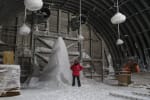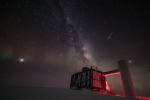Nice snow drift! Or sastruga, as one might say at the Pole. This enormous snow structure appeared inside the logistics arch, which is a large unheated storage facility, pushed through to the inside through closed doors. That is one strong wind (or one leaky door). […]
News
Week 22 at the Pole
Since it’s nighttime all the time during winter at the South Pole, it can be pretty dark outside, depending on the weather. But with clear conditions, you can get a wondrous night sky. Here we have the IceCube Lab under quite the starry sky, with the Milky Way in clear view and an Iridium flare making a noticeable mark. […]
IceCube at Neutrino 2018
The 2018 IceCube delegation at the Neutrino conference includes 22 researchers presenting 20 posters and two plenary talks. […]
Week 21 at the Pole
Last time it was frosted glasses, now it’s a frosty staircase. Blowing snow during the recent storms has left its mark on the staircase and platforms of the IceCube Lab (ICL). At some point, that snow will need to be removed—but that’s for another day. […]
Week 20 at the Pole
The winds kept at it last week. The blowing snow not only obstructs the view when trying to take photos, but it makes it tricky to see the flags that mark your way in this dangerously cold landscape. The weather did clear at one point, though, long enough to capture some amazing shots of the Milky Way. […]
Week 19 at the Pole
A quiet week at the Pole for the detector, but he photos were just striking! Here we have a nice shot of the ceremonial pole marker, with a bright moon situated just behind the sphere and flags flapping in the wind. […]
Week 18 at the Pole
Even in winter, you can get an impressive halo—here it’s the moon. Halos are caused by light interacting with ice crystals suspended in the atmosphere, and these circular halos, which can form around the sun or the moon, are called 22-degree halos. They’re fairly common, seen more frequently than rainbows. […]
The IceCube Collaboration meeting in Atlanta begins today!
Hosted by Georgia Tech, the spring IceCube Collaboration meeting starts today in Atlanta. Two hundred IceCube collaborators from 49 institutions will meet to discuss about a variety of topics, including the future expansion of IceCube. […]
Week 17 at the Pole
Last week was fairly relaxed at the Pole. Some testing and troubleshooting with the detector, but all went rather smoothly. As for the skies? They were glowing. And swirling, and shimmering. The auroras sometimes swirl into shapes suggesting all kinds of things. […]
Week 16 at the Pole
Although the sky is not yet dark, auroras appeared for the first time this austral winter. It was a good thing the detector ran well this week, because the winterovers were excited to experiment photographing the colorful night sky. […]









